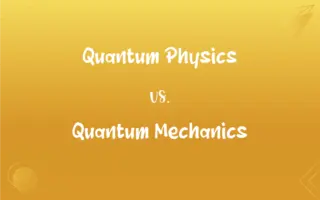Voltage vs. Current: What's the Difference?
Edited by Aimie Carlson || By Harlon Moss || Updated on June 4, 2024
Voltage is the electric potential difference; current is the flow of electric charge.

Key Differences
Voltage, often denoted by the symbol V, refers to the electric potential difference between two points in a circuit. Current, represented by the symbol I, quantifies the flow of electric charge through a conductor.
The concept of voltage is analogous to the pressure in a water hose, which pushes water forward. In contrast, current resembles the flow rate of the water, or how much water passes through the hose over a given time.
Voltage can exist without current, much like a battery that isn't connected to any device. It holds potential energy but isn't causing a flow of charge. Conversely, for current to exist, there must be a voltage to drive it, similar to how water requires pressure to flow.
Ohm's Law, a fundamental principle in electronics, relates voltage and current using resistance as a factor. The law states that voltage (V) is equal to the current (I) times resistance (R), highlighting their interconnected nature.
It's essential to understand that while voltage can influence current, they are distinct entities. Increasing voltage in a circuit generally increases the current, assuming resistance remains constant. However, factors like resistance can affect the relationship between voltage and current.
ADVERTISEMENT
Comparison Chart
Definition
Electric potential difference between two points
Flow of electric charge through a conductor
Symbol
V
I
Dependency
Can exist without current
Requires voltage to exist
Analogy
Similar to pressure in a water system
Comparable to the flow rate of water
Units
Measured in volts (V)
Measured in amperes (A)
ADVERTISEMENT
Voltage and Current Definitions
Voltage
Can exist without a flowing current.
The unused battery has a voltage, even if no current flows from it.
Current
Affected by voltage and resistance in a circuit.
Increasing the resistance will decrease the current, given a constant voltage.
Voltage
Force that pushes electric charge in a circuit.
The voltage of the power source determines the brightness of the bulb.
Current
Flow of electric charge through a conductor.
The current in the wire heats it up, making the filament glow.
Voltage
Electric potential difference between two points.
The voltage across the terminals of the battery is 12V.
Current
Measured in amperes or amps (A).
The device draws a current of 2A when operating.
Voltage
Measured using a voltmeter.
By using a voltmeter, he determined the voltage drop across the resistor.
Current
Can vary as direct (DC) or alternating (AC).
Household outlets provide an alternating current.
Voltage
A measure of electric potential energy per unit charge.
High voltage lines carry electricity over long distances.
Current
Direction is from positive to negative in conventional flow.
The current flows from the battery's positive terminal to its negative one.
Voltage
A measure of the difference in electric potential between two points in space, a material, or an electric circuit, expressed in volts.
Current
Belonging to the present time; present-day
Current events.
Current leaders.
My current address.
Voltage
(electricity) The difference in electrostatic potential between two points in space, especially between live and neutral conductors or the earth.
The voltage between the wires is too low to produce a spark.
Be careful when opening high-voltage equipment.
Voltage
Electric potential or potential difference, expressed in volts.
Voltage
The rate at which energy is drawn from a source that produces a flow of electricity in a circuit; expressed in volts
Voltage
The difference in electrical charge between two points in a circuit expressed in volts
FAQs
How is current defined?
Current is the flow of electric charge through a conductor.
What are the units of current?
Current is measured in amperes or amps (A).
Can current exist without voltage?
No, current requires a voltage to drive its flow.
What's an example of a device that measures current?
An ammeter is used to measure current.
Can voltage exist without current?
Yes, voltage can exist without a flowing current, like in an unused battery.
How do voltage and current relate in Ohm's Law?
Ohm's Law states that voltage (V) is equal to current (I) times resistance (R).
How can current be dangerous?
Excessive current can produce heat, leading to burns or fires, and can also cause electric shock.
What is voltage?
Voltage is the electric potential difference between two points in a circuit.
Does current always require voltage?
Yes, for current to flow, there needs to be a voltage driving it.
How is voltage measured?
Voltage is measured in volts (V) using a voltmeter.
What's the difference between AC and DC current?
AC current reverses direction periodically, while DC current flows consistently in one direction.
Can circuits have both AC and DC current?
Yes, some circuits, like those in radios, can utilize both AC and DC currents.
What role does voltage play in electronic devices?
Voltage provides the necessary electric potential to power and operate electronic devices.
Why is voltage sometimes called "potential difference"?
Because it represents the potential energy difference per unit charge between two points.
Is voltage directly proportional to energy?
Not always. While voltage is related to energy, the energy in a circuit also depends on the current and resistance.
Why is it important to understand voltage and current in electronics?
Understanding voltage and current is essential for designing, troubleshooting, and safely using electronic devices.
Can increasing voltage affect current?
Yes, generally, increasing voltage in a circuit increases the current, assuming constant resistance.
Do voltage and current always have a direct relationship?
Not always. While they're related, other factors like resistance can influence their relationship.
How does a battery produce voltage?
A battery produces voltage through chemical reactions that create an electric potential difference.
What happens to current if resistance in a circuit increases?
If resistance increases and voltage remains constant, the current will decrease.
About Author
Written by
Harlon MossHarlon is a seasoned quality moderator and accomplished content writer for Difference Wiki. An alumnus of the prestigious University of California, he earned his degree in Computer Science. Leveraging his academic background, Harlon brings a meticulous and informed perspective to his work, ensuring content accuracy and excellence.
Edited by
Aimie CarlsonAimie Carlson, holding a master's degree in English literature, is a fervent English language enthusiast. She lends her writing talents to Difference Wiki, a prominent website that specializes in comparisons, offering readers insightful analyses that both captivate and inform.






































































